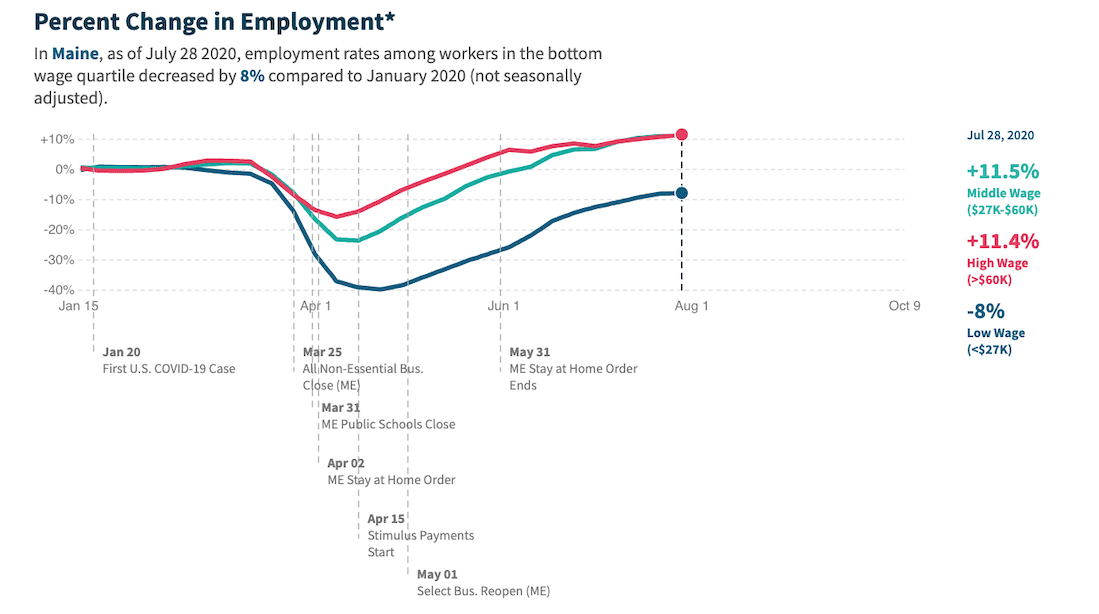Three major Maine colleges and universities haven’t had a new positive COVID-19 case for more than a week, and Bates and Bowdoin colleges have zero active COVID-19 cases among students.
Just across the border, the University of New Hampshire has 18 active cases, including six students in isolation and 29 other students in quarantine, as of Friday. The school has had 219 total positive cases since July 29, but has also administered over 160,000 tests in that time.
Colby College had no active cases as of Friday and hasn’t recorded a new case this month. Five students are currently in quarantine at the Waterville school. Colby has recorded 11 total positive cases overall: seven students and four employees, all of whom have recovered. The school has had more than 48,000 tests come back negative, according to its COVID-19 dashboard.
Colby remains at a “green” operating level, which means programs and activities are open with restrictions on group sizes, and the school limits the number of seats in classrooms, dining halls and other spaces. Buildings require card access and use directional signage.
As of Friday, Bowdoin had no active student or employee cases, according to its coronavirus dashboard. In total, three Bowdoin students and one employee have tested positive; all have recovered. The Brunswick-based college has conducted more than 9,380 student tests and 8,761 employee tests since campus reopened.
Bowdoin is at a “yellow” level, which is the school’s safest ranking. Student services are available in person by appointment only, academic buildings are open with student card access and dining is allowed for students in preselected cohorts or at preselected times. More information on restrictions is available here.
Two Bates College students tested positive early in the school year but have recovered. The most recent positive test was on Sept. 1. As of Oct. 8, the school had conducted nearly 22,000 student tests and 3,600 employee tests. Only one employee has tested positive.
The University of Maine system has seen 17 positive cases — including four in the last two weeks. As of Oct. 9, there were six active cases: three at the University of Maine flagship campus in Orono; two at the University of Maine-Augusta; and one at the University of Maine-Farmington.
Through Friday, St. Joseph’s College had identified 11 positive COVID-19 cases on campus — but none in the last week. On Sept. 13, the Windham-based college ordered all students to study in place for two weeks after nine tests came back positive early in the school year.
The University of New England has seen 12 positive student tests at its Biddeford and Portland campuses, but no new cases in three weeks. Four UNE employees have tested positive. Husson College has one active student case and one recovered employee case. And, as of Oct. 6, Thomas College had reported no new positive cases in the last two weeks.
Employment has surpassed pre-pandemic rates in Maine, not nationally
After significant problems at the beginning of the COVID-19 pandemic, Maine’s overall employment situation has improved — and even surpassed January employment rates — according to the latest data from Track the Recovery.
Track the Recovery’s numbers, however, are not seasonally adjusted to reflect the higher employment rates in Maine during summer months. Overall employment in August still was significantly lower than the same time last year, according to the state Department of Labor.
Most of that deficit comes from the state’s lowest-paying jobs, which have not rebounded like high-wage and middle-wage jobs in Maine.

The state’s employment rebound is buoyed by growth in the high-wage category, which is up 11.4 percent compared to January, and the middle-wage category, which is up 11.5 percent over pre-pandemic numbers.
Low-wage jobs in the state — many associated with the restaurant and hospitality industries — have not rebounded yet and are still 8.1 percent below pre-pandemic levels.
Maine’s employment rebound runs counter to what is being felt across the country. Employment remains down in all three wage groups nationally:
- High-wage jobs (over $60,000 annually) are 1.6 percent below pre-pandemic levels.
- Middle-wage jobs ($27,000-$60,000) are down 5.3 percent since January.
- And, low-wage jobs (less than $27,000) are down 16.1 percent.
Track the Recovery is a product of Opportunity Insights, a real-time economics data website produced by Harvard University that allows users to understand the impact of the coronavirus on people, businesses and local communities .
Maine receives funding for Alzheimer’s services
The Maine Center for Disease Control and Prevention has been awarded $200,000 to expand support services for people with dementia and Alzheimer’s disease.
The Maine CDC is among 15 public health entities to receive the federal funding, according to a press release. The funding, which could be renewed annually through 2023, is intended to increase early detection and diagnosis, reduce risk, prevent avoidable hospitalizations and support dementia caregiving.
The state agency applied for the funding in partnership with the Maine Office of Aging and Disability Services.
“This award is a result of the strong work being done to meet the needs of aging Mainers,” Maine CDC director Nirav Shah said. “The additional funding will help expand those efforts at a time when demographic trends signal a growing need.”
About 5.8 million Americans live with Alzheimer’s disease, which affects parts of the brain that control thought, memory and language. It’s a progressive disease that requires constant caregiving. More than 16 million Americans provide unpaid care for people living with Alzheimer’s, according to the Maine CDC.
Maine, which has the nation’s oldest median age and highest percentage of people over age 65, is projected to see a 25 percent increase in residents with Alzheimer’s by 2025, according to the CDC.
WIC nutrition program moves to electronic system
The Women, Infants and Children (WIC) nutrition program in Maine recently transitioned from paper vouchers to a benefit card system.
Through the new system, called eWIC, benefits for food automatically are entered onto an electronic benefit transfer card, similar to a debit card, according to a press release.
The program serves more than 16,500 pregnant, postpartum and breastfeeding women, infants and children in Maine. It provides food, nutrition education, breastfeeding support and referrals to other services. Participants must meet income guidelines, live in Maine and be determined by a health professional to be at “nutritional risk.”
eWIC operates in all 16 counties in Maine. Stores that want to enroll as a new vendor can find more information online.







